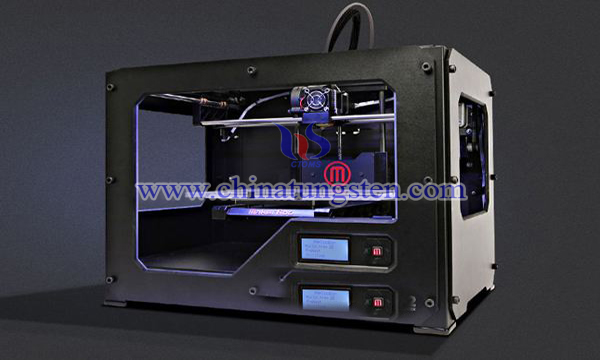Pure Tungsten 3D Printing Additive Manufacturing Exploration
- Details
- Category: Tungsten Information
- Published on Monday, 19 November 2018 22:44
Additional material manufacturing is a new processing technology, commonly known as 3D printing, which is different from the traditional "removal" manufacturing. It does not need the original embryo and die. It directly forms any complex shape object by adding material layer by layer according to the computer three-dimensional model data of parts.

At present, there are many researches on material addition of titanium alloy, stainless steel and nickel base alloy at home and abroad. However, for refractory metals and alloys, such as tungsten, molybdenum, tantalum and vanadium, it is difficult to break through due to their inherent physical properties, such as melting point, density, thermal conductivity, melt tension and viscosity, which mainly has the disadvantages of unstable droplets, remarkable spheroidization and low density.
As countries such as Europe and the United States continue to apply metal 3D printed products to aerospace, military, space and other fields that determine the future of mankind, China is also striving to shorten the gap with European and American countries. Selective Laser Melting (SLM) is a more popular 3D additive printing solution currently applied to refractory metals. In this solution, special pretreatment methods and process measures are adopted to ensure the dense molding of pure tungsten metal. Its novelty is guaranteed by a series of process measures to reduce the defects of pure tungsten additive forming and increase the density. The main process of additive manufacturing is:
1)screening and proportioning of tungsten powder particles
2) laser forming and remelting
A. Using German additive manufacturing equipment, the multi-layer composite iron-insulating material-tungsten substrate is installed on the working platform, preheated to 300 ℃ and maintained at this temperature during laser forming and remelting. The gap between the POWDER-LAYING scraper and the multi-layer composite iron-insulating material-tungsten substrate is 30 micrometers; in the argon-protected glove box, the mixed powder is prepared by 1) The body is filled into a powder bin.
B.Sealed forming chamber, pumping vacuum to the relative vacuum of - 90KPa, injecting protective gas argon into the forming chamber; repeatedly pumping vacuum and importing protective gas argon, so that oxygen content in the forming chamber can be reduced to less than 300 ppm.
C. Scanning the "sacrificial area 4" of multi-layer composite iron-insulating material-tungsten substrate by laser, consuming residual oxygen in the forming chamber until the oxygen content drops below 50 ppm.
D.The powder laying mechanism feeds the mixed powder in the powder silo onto the multi-layer composite iron-insulating material-tungsten substrate, and is paved by the powder laying scraper to obtain a 30-micron thickness powder layer.
E.Starting forming, the mixed powder of section area 1 was melted by high-energy laser beam. Within 30 minutes, the oxygen content in the forming chamber was reduced to less than 1 ppm, and the oxygen content in the forming chamber was always less than 1 ppm during the laser forming and remelting process. Laser power was more than 400 W, the point distance was 50 microns, the exposure time was 250 microns, and the scanning distance was 100 microns.
F. Do not mix powder, laser re scanning remelting. The angle between the scanning direction and the scanning direction of laser remelting is 90 degrees; the parameter is the same as that of E.
G.After the remelting is completed, the working platform is lowered by a slice thickness of 30 μm;
H. Repeat step E-G, until the entire part is formed, to obtain a small piece of pure tungsten, tungsten forming density of 18g / cm3 or more, relative density of 93% or more
Through the above process, the additive manufacturing of pure tungsten metal is completed, and the spherical tungsten powder ratio optimization and molding process measures are adopted to ensure the instability, spheroidization and defects of the molten droplet state existing in the manufacture of pure tungsten metal additive. Problems such as more holes, improved forming density and component performance, and high density required for finished products.
- Tungsten Manufacturer & Supplier, Chinatungsten Online: www.chinatungsten.com
- Tungsten News & Prices of China Tungsten Industry Association: www.ctia.com.cn
- Molybdenum News & Price: news.molybdenum.com.cn
- Tel.: 86 592 5129696; Fax: 86 592 5129797; Email: sales@chinatungsten.com



 sales@chinatungsten.com
sales@chinatungsten.com